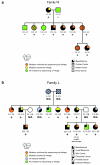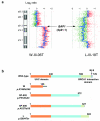Germline BAP1 mutations predispose to malignant mesothelioma
- PMID: 21874000
- PMCID: PMC3184199
- DOI: 10.1038/ng.912
Germline BAP1 mutations predispose to malignant mesothelioma
Abstract
Because only a small fraction of asbestos-exposed individuals develop malignant mesothelioma, and because mesothelioma clustering is observed in some families, we searched for genetic predisposing factors. We discovered germline mutations in the gene encoding BRCA1 associated protein-1 (BAP1) in two families with a high incidence of mesothelioma, and we observed somatic alterations affecting BAP1 in familial mesotheliomas, indicating biallelic inactivation. In addition to mesothelioma, some BAP1 mutation carriers developed uveal melanoma. We also found germline BAP1 mutations in 2 of 26 sporadic mesotheliomas; both individuals with mutant BAP1 were previously diagnosed with uveal melanoma. We also observed somatic truncating BAP1 mutations and aberrant BAP1 expression in sporadic mesotheliomas without germline mutations. These results identify a BAP1-related cancer syndrome that is characterized by mesothelioma and uveal melanoma. We hypothesize that other cancers may also be involved and that mesothelioma predominates upon asbestos exposure. These findings will help to identify individuals at high risk of mesothelioma who could be targeted for early intervention.
Figures




Comment in
-
Germline BAP1 mutations and tumor susceptibility.Nat Genet. 2011 Sep 28;43(10):925-6. doi: 10.1038/ng.956. Nat Genet. 2011. PMID: 21956388 Free PMC article.
Similar articles
-
Inference on germline BAP1 mutations and asbestos exposure from the analysis of familial and sporadic mesothelioma in a high-risk area.Genes Chromosomes Cancer. 2015 Jan;54(1):51-62. doi: 10.1002/gcc.22218. Epub 2014 Sep 18. Genes Chromosomes Cancer. 2015. PMID: 25231345
-
Germline mutation of Bap1 accelerates development of asbestos-induced malignant mesothelioma.Cancer Res. 2014 Aug 15;74(16):4388-97. doi: 10.1158/0008-5472.CAN-14-1328. Epub 2014 Jun 13. Cancer Res. 2014. PMID: 24928783 Free PMC article.
-
Well-differentiated papillary mesothelioma: clustering in a Portuguese family with a germline BAP1 mutation.Ann Oncol. 2013 Aug;24(8):2147-50. doi: 10.1093/annonc/mdt135. Epub 2013 Apr 12. Ann Oncol. 2013. PMID: 23585512
-
Further evidence for germline BAP1 mutations predisposing to melanoma and malignant mesothelioma.Cancer Genet. 2013 May;206(5):206-10. doi: 10.1016/j.cancergen.2013.05.018. Cancer Genet. 2013. PMID: 23849051 Review.
-
Medical and Surgical Care of Patients With Mesothelioma and Their Relatives Carrying Germline BAP1 Mutations.J Thorac Oncol. 2022 Jul;17(7):873-889. doi: 10.1016/j.jtho.2022.03.014. Epub 2022 Apr 21. J Thorac Oncol. 2022. PMID: 35462085 Free PMC article. Review.
Cited by
-
The role of single nucleotide polymorphisms related to iron homeostasis in mesothelioma susceptibility after asbestos exposure: a genetic study on autoptic samples.Front Public Health. 2023 Oct 24;11:1236558. doi: 10.3389/fpubh.2023.1236558. eCollection 2023. Front Public Health. 2023. PMID: 37942251 Free PMC article.
-
Positive nuclear BAP1 immunostaining helps differentiate non-small cell lung carcinomas from malignant mesothelioma.Oncotarget. 2016 Sep 13;7(37):59314-59321. doi: 10.18632/oncotarget.10653. Oncotarget. 2016. PMID: 27447750 Free PMC article.
-
Changing pattern in malignant mesothelioma survival.Transl Oncol. 2015 Feb;8(1):35-9. doi: 10.1016/j.tranon.2014.12.002. Transl Oncol. 2015. PMID: 25749175 Free PMC article.
-
Precision Surgery and Kidney Cancer: Knowledge of Genetic Alterations Influences Surgical Management.Genes (Basel). 2021 Feb 11;12(2):261. doi: 10.3390/genes12020261. Genes (Basel). 2021. PMID: 33670168 Free PMC article. Review.
-
A cryptic BAP1 splice mutation in a family with uveal and cutaneous melanoma, and paraganglioma.Pigment Cell Melanoma Res. 2012 Nov;25(6):815-8. doi: 10.1111/pcmr.12006. Epub 2012 Oct 1. Pigment Cell Melanoma Res. 2012. PMID: 22889334 Free PMC article.
References
-
- Flores RM, et al. Extrapleural pneumonectomy versus pleurectomy/decortication in the surgical management of malignant pleural mesothelioma: results in 663 patients. J. Thorac. Cardiovasc. Surg. 2008;135:620–626. - PubMed
-
- Tweedale G. Asbestos and its lethal legacy. Nat. Rev. Cancer. 2002;2:311–315. - PubMed
-
- Moolgavkar SH, Meza R, Turim J. Pleural and peritoneal mesotheliomas in SEER: age effects and temporal trends, 1973-2005. Cancer Causes Control. 2009;20:935–944. - PubMed
Publication types
MeSH terms
Substances
Grants and funding
LinkOut - more resources
Full Text Sources
Other Literature Sources
Medical
Molecular Biology Databases
Research Materials
Miscellaneous

